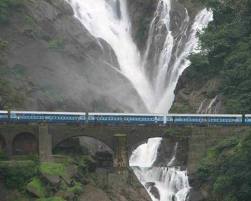The Harmandir Sahib ,Darbar Sahib also referred as the Golden Temple,is a prominent Sikh gurdwara located in the city of Amritsar, Punjab (India). Construction of the gurdwara was begun by Guru Ram Das, the fourth Sikh Guru, and completed by his successor, Guru Arjan Dev. In 1604, Guru Arjan Dev completed the Adi Granth, the holy scripture of Sikhism, and installed it in the Gurdwara. During the eighteenth century, the Harmandir Sahib was the site of frequent fighting between the Sikhs on one side and either Mughal or Afghan forces on the other side and the gurdwara occasionally suffered damage. In the early nineteenth century, Maharaja Ranjit Singh secured the Punjab region from outside attack and covered the upper floors of the gurdwara with gold, which gives it its distinctive appearance and English name of "Golden Temple".


The Golden Temple is considered holy by Sikhs because the eternal guru of Sikhism, the Sri Guru Granth Sahib, is always present inside it and its construction was mainly intended to build a place of worship for men and women from all walks of life and all religion to come and worship God equally.[1][6] The Sri Guru Granth Sahib is the holiest literature in the Sikh religion,[6] the tenth guru of Sikhism, Guru Gobind Singh, on 7 October 1708 at Nanded made it the eternal Sikh Guru and the leader of Sikhism.[6] Anywhere in the world where the Guru Granth Sahib is present is equally holy and precious to Sikhs. Amritsar is the location of Harmandir Sahib.
Its name literally means Temple of God.The fourth guru of Sikhism, Guru Ram Das, excavated a tank in 1577 CE which subsequently became known as Amritsar (meaning "Pool of the Nectar of Immortality"),Harmandir Sahib (meaning "the abode of God"),[8] rose in the middle of this tank and became the supreme centre of Sikhism. Its sanctum came to house the Adi Granth comprising compositions of Sikh gurus and other saints considered to have Sikh values and philosophies, e.g., Baba Farid, and Kabir. The compilation of the Adi Granth was started by the fifth guru of Sikhism, Guru Arjan Dev.
Construction of the Harmandir Sahib
Originally built in 1574, the site of the temple was surrounded by a small lake in a thin forest. The third of the six grand Mughals, Emperor Akbar, who visited the third Sikh guru, Guru Amar Das, in the neighbouring town of Goindval, was so impressed by the way of life in the town that he gave a jagir (the land and the revenues of several villages in the vicinity) to the guru's daughter Bhani as a gift on her marriage to Bhai Jetha, who later became the fourth Sikh guru, Guru Ram Das. Guru Ram Das enlarged the lake and built a small township around it. The town was named after Guru Ram Das as Guru Ka Chak', Chak Ram Das or Ram Das Pura.

During the leadership of the fifth guru, Guru Arjan Dev (1581–1606), the full-fledged Temple was built. In December 1588, the great Muslim Sufi saint of Lahore, Hazrat Mian Mir, who was a close friend of Guru Arjan Dev Ji, initiated the construction of the temple by laying the first foundation stone (December 1588 CE). A mason then straightened the stone but Guru Arjan Dev told him that, as he had undone the work just completed by the holy man, a disaster might come to the Harmandir Sahib. It was later attacked by the Mughals.
The temple was completed in 1604. Guru Arjan Dev, installed the Guru Granth Sahib in it and appointed Baba Buddha Ji as the first Granthi (reader) of it on August 1604. In the mid-18th century it was attacked by the Afghans, by one of Ahmed Shah Abdali's generals, Jahan Khan, and had to be substantially rebuilt in the 1760s. However, in response a Sikh Army was sent to hunt down the Afghan force. They were under orders to show no mercy and historical evidence suggests the Sikh Army was decisively victorious in the ensuing battle. Both forces met each other five miles outside Amritsar; Jahan Khan's army was destroyed. He himself was decapitated by commander Sardar Dayal Singh.
Celebrations at Harmandir Sahib
One of the most important festivals is Vaisakhi, which is celebrated in the second week of April (usually the 13th). Sikhs celebrate the founding of the Khalsa on this day and it is celebrated with fervour in the Harmandir Sahib. Other important Sikh religious days such as the martyrdom day of Guru Teg Bahadur, the birthday of Guru Nanak, etc., are also celebrated with religious piety. Similarly Diwali is one of the festivals which sees the Harmandir Sahib beautifully illuminated with Divas/Diyas (lamps); lights and fireworks are discharged. During these special occasions many thousands of people visit the holy shrine named Harmandir Sahib.
HOW TO REACH GOLDEN TEMPLE
Air : Flights operate to the Rajasansi airport at Amritsar from many national destinations. A few international flights also land at the airport.
Rail : Amritsar is well connected by railway network. Regular trains operate between Amritsar and national capital Delhi.
Road : Buses are available to Amritsar from Delhi and other destinations of Punjab. Amritsar is at a distance of 234 kms from Chandigarh and 464 kms from Delhi.
GET DIRECTIONS











